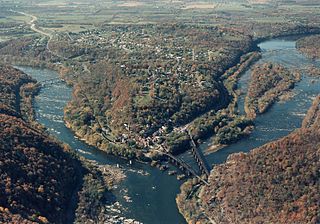
Sewickley is a borough in Allegheny County, Pennsylvania, 12 miles (19 km) west northwest of Pittsburgh along the Ohio River. It is a residential suburb of Pittsburgh. The population was 3,827 at the 2010 census. The Sewickley Bridge crosses the Ohio River at Sewickley.

Chartiers Township is a township in Washington County, Pennsylvania, United States. The population was 7,818 at the 2010 census. Along with the borough of Houston the township makes up the Chartiers-Houston School District.

The Kittanning Path was a major east-west Native American trail that crossed the Allegheny Mountains barrier ridge connecting the Susquehanna River valleys in the center of Pennsylvania to the highlands of the Appalachian Plateau and thence to the western lands beyond drained by the Ohio River. Kittanning Village was the first major Delaware (Lenape) Indian settlement along the descent from the Allegheny Plateau.

The Clarion River is a tributary of the Allegheny River, approximately 110 mi (177 km) long, in west central Pennsylvania in the United States. It drains a rugged area of the Allegheny Plateau in the Ohio River watershed, flowing through narrow serpentine valleys and hardwood forests.

Chartiers is a neighborhood in Pittsburgh, Pennsylvania's west area. It has a zip code of 15204, and has representation on Pittsburgh City Council by the council member for District 2. The neighborhood was named after Peter Chartier, a trapper of French and Native American parentage who established a trading post at the mouth of Chartiers Creek in 1743.
The Chartiers branch of the Pennsylvania Railroad followed Chartiers Creek from Carnegie to Washington, passing Bridgeville, present day Southpointe, and Canonsburg. It is 23.6 miles (38.0 km) long and construction was completed in 1867 and is still in use today, after passing through at least seven different owners.

The Casselman River is a 56.5-mile-long (90.9 km) tributary of the Youghiogheny River in western Maryland and Pennsylvania in the United States.

Lower Shawneetown (15Gp15), also known as the Bentley Site, Shannoah and Sonnontio, is a Late Fort Ancient culture Madisonville horizon archaeological site overlain by an 18th-century Shawnee village; it is located near South Portsmouth in Greenup County, Kentucky. It was added to the National Register of Historic Places on April 28, 1983.
Pekowi was the name of one of the five divisions of the Shawnee, a Native American people, during the 18th century. The other four divisions were the Chalahgawtha, Mekoche, Kispoko, and Hathawekela. Together these divisions formed the loose confederacy that was the Shawnee tribe.

Chartiers Creek is a tributary of the Ohio River in Western Pennsylvania in the United States. The creek was named after Peter Chartier, a trapper of French and Native American parentage who established a trading post at the mouth of the creek in 1743.
Chartiers may refer to the following places in Pennsylvania:
The Honniasont were a little-known indigenous people of North America originally from eastern Ohio, western Pennsylvania and West Virginia. They appear to have inhabited the upper Ohio River valley, above Louisville, Kentucky.

The Cranberry Wilderness is a 47,815-acre (19,350 ha) U.S. wilderness area in the Monongahela National Forest of southeast West Virginia, United States. Its name derives from the nearby Cranberry Glades as well as from the Cranberry River and Cranberry Mountain. In addition to being wilderness, it is a designated black bear sanctuary.
Chartiers Run is a tributary of Chartiers Creek in Washington County, Pennsylvania in the United States. It was named after Peter Chartier, a trapper of French and Native American parentage who established a trading post at the mouth of Chartiers Creek in 1743.

Indian Old Fields was an unincorporated community located in Clark County, Kentucky, United States.
Peter Chartier (1690—c.1759) was a fur trader of French and Shawnee parentage who became a tribal chief and was an early advocate for Native American civil rights, speaking out against the sale of alcohol in indigenous communities in Pennsylvania. He first attempted to limit the sale of rum in Shawnee communities in the Province of Pennsylvania, then launched a movement to prohibit it altogether. Conflict with the colonial government motivated him to lead his community of over 400 Pekowi Shawnees on a four-year odyssey through Ohio, Kentucky, Alabama and Indiana, eventually resettling in Illinois. He later fought on the side of the French during the French and Indian War.
Nemacolin was a hereditary chief of the Delaware Nation who helped Thomas Cresap widen a Native American path across the Allegheny Mountains to the Ohio River Valley.
Martin Chartier was a French-Canadian explorer, a glove maker, and then a "white Indian", living much of his life amongst the Shawnee Native Americans.

The gaps of the Allegheny, meaning gaps in the Allegheny Ridge in west-central Pennsylvania, is a series of escarpment eroding water gaps along the saddle between two higher barrier ridge-lines in the eastern face atop the Allegheny Ridge or Allegheny Front escarpment. The front extends south through Western Maryland and forms much of the border between Virginia and West Virginia, in part explaining the difference in cultures between those two post-civil war states. While not totally impenetrable to daring and energetic travelers on foot, passing the front outside of the water gaps with even sure footed mules was nearly impossible without navigating terrain where climbing was necessary on slopes even burros would find extremely difficult.














